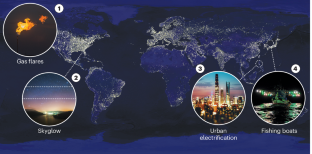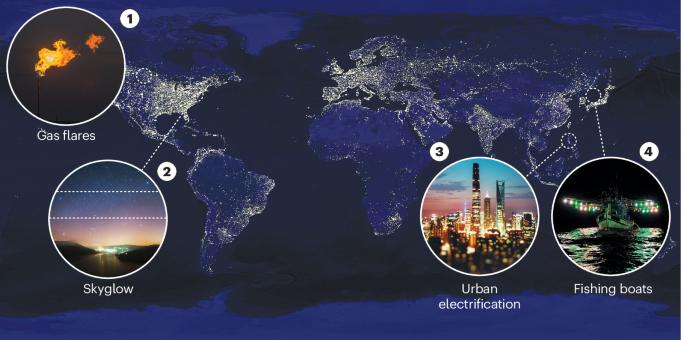Monitoring, trends and impacts of light pollution
引用次数: 0
Abstract
Light pollution has increased globally, with 80% of the total population now living under light-polluted skies. In this Review, we elucidate the scope and importance of light pollution and discuss techniques to monitor it. In urban areas, light emissions from sources such as street lights lead to a zenith radiance 40 times larger than that of an unpolluted night sky. Non-urban areas account for over 50% of the total night-time light observed by satellites, with contributions from sources such as transportation networks and resource extraction. Artificial light can disturb the migratory and reproductive behaviours of animals even at the low illuminances from diffuse skyglow. Additionally, lighting (indoor and outdoor) accounts for 20% of global electricity consumption and 6% of CO2 emissions, leading to indirect environmental impacts and a financial cost. However, existing monitoring techniques can only perform a limited number of measurements throughout the night and lack spectral and spatial resolution. Therefore, satellites with improved spectral and spatial resolution are needed to enable time series analysis of light pollution trends throughout the night. Increasing light emissions threaten human and ecological health. This Review outlines existing measurements and projections of light pollution trends and impacts, as well as developments in ground-based and remote sensing techniques that are needed to improve them.


光污染的监测、趋势和影响
全球光污染日益严重,目前有 80% 的总人口生活在光污染的天空下。在这篇综述中,我们将阐明光污染的范围和重要性,并讨论监测光污染的技术。在城市地区,路灯等光源产生的光辐射导致天顶辐射比未受污染的夜空大 40 倍。卫星观测到的夜间光照总量中,50% 以上来自非城市地区,其中包括交通网络和资源开采等光源。即使漫反射天光的照度很低,人工光也会干扰动物的迁徙和繁殖行为。此外,照明(室内和室外)占全球耗电量的 20%,占二氧化碳排放量的 6%,对环境造成间接影响,并带来经济损失。然而,现有的监测技术只能在整个夜间进行数量有限的测量,而且缺乏光谱和空间分辨率。因此,需要改进光谱和空间分辨率的卫星,以便对整夜的光污染趋势进行时间序列分析。不断增加的光辐射威胁着人类和生态健康。本综述概述了对光污染趋势和影响的现有测量和预测,以及改进这些测量和预测所需的地面和遥感技术的发展。
本文章由计算机程序翻译,如有差异,请以英文原文为准。
求助全文
约1分钟内获得全文
求助全文

 求助内容:
求助内容: 应助结果提醒方式:
应助结果提醒方式:


